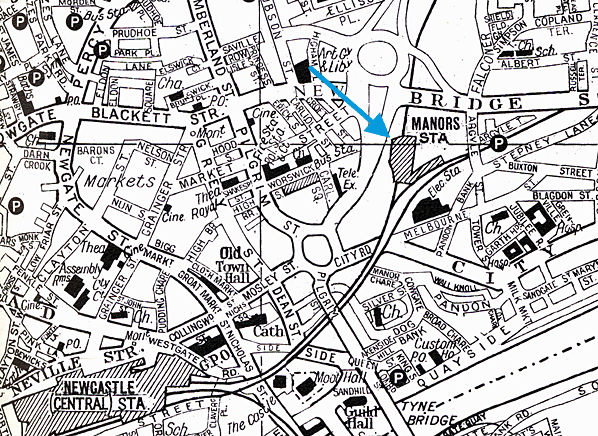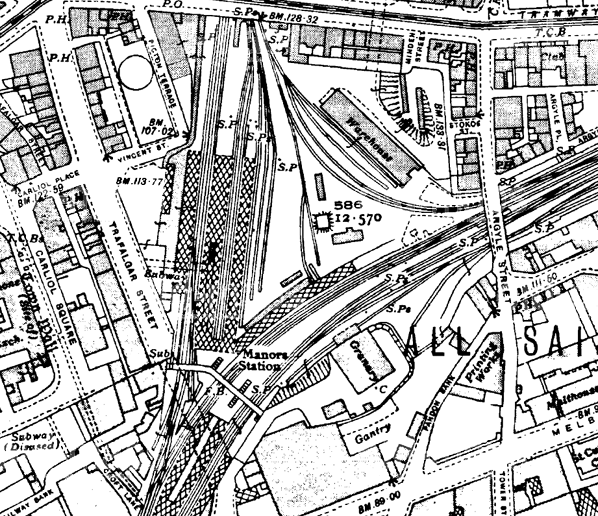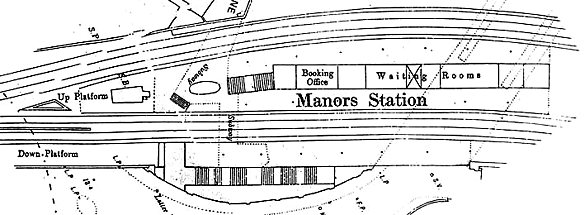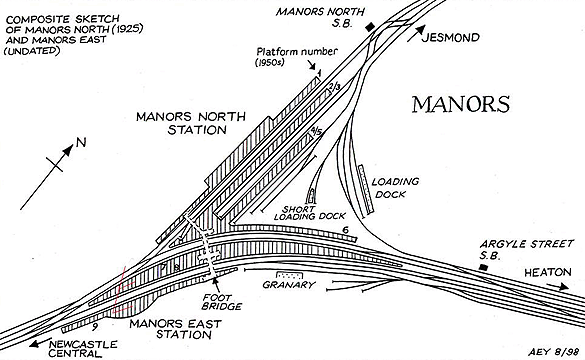
Station Name: MANORS EAST
|
| Date opened: | 30 August 1850 |
| Location: | East of Trafalgar Street and north of Melbourne Street |
| Company on opening: | York Newcastle & Berwick Railway. |
| Date closed to passengers: | Still open |
| Date closed completely: | Still open |
| Company on closing: | Still open |
| Present state: | A new, shorter island platform (7 & 8) has been built and is still open. The abandoned sections of platform 7 & 8 and the adjacent platform 9 are extant but devoid of all buildings. The subways and stairs beneath platform 7 & 8 are also still extant but is being (2005) converted into a restaurant. |
| County: | Northumberland |
| OS Grid Ref: | NZ253643 |
| Date of visit: | 1984 & 9.7.2005 |
|
Notes: Known by local people as ‘The Manors’, the name refers to the area on the edge of Newcastle’s city centre which was almost obliterated by the station as it grew into an extravagant nine-platform affair. Passengers travelling from Newcastle towards Benton gained a vivid impression of the station’s vastness, as first the Coast Circle via Wallsend platforms (8 and 9) curved away, followed by the East Coast main line platforms (6 and 7), before the train drew in to platform 1, with numbers 2 (for trains from Benton to Newcastle) and 3 to 5 (for Blyth and Newbiggin services) to the right. Today a single island platform on the East Coast main line is all that remains. From 1909 until 1969 Manors was officially two separate stations – East and North – but the latter closed in January 1978.
In 1864 the Blyth & Tyne Railway (B&T) entered Newcastle from the north, opening its New Bridge Street terminus about 300yd north of Manors. This station would eventually, in 1909, be superseded by Manors (North). The North Eastern Railway (NER), which absorbed the York, Newcastle & Berwick Railway (as the N&B had become) in 1854 went on, twenty years later, to absorb the B&T.
The next significant development was beside the railway rather than on it. In 1901 Manors power station opened to supply electricity to the city's tramway system. This competition stimulated not only the electrification of the existing railway lines between the city and the coast but also the eventual construction of the Manors-New Bridge Street link with new platforms at Manors (North) which opened on 1 July 1909.
Although in practice one station, and the nameboards bore the name ‘Manors’, the old and new parts were officially Manors East and North from 1 January 1909 until 20 February 1969. Some tickets referred to East and North, as did LNER timetables until June 1947. In British Railways days working timetables still distinguished East from North. Public timetables indicated by footnotes that express services from Monkseaton via the East Coast main line called at the East rather than the North platforms.
The variety of passenger services began to decline when, on 2 November 1964, Blyth / Newbiggin trains were withdrawn, making Manors (North) platforms 3 to 5 redundant. The few Riverside Branch trains ceased from 23 July 1973. Much more significantly trains were withdrawn permanently from Manors (North) when the Coast service via Benton ended on 23 January 1978 in preparation for Metro works: Coast trains via Wallsend continued to use Manors (East) until 11 August 1980. On 14 November 1982 a regular local passenger service resumed at Manors, but using the new underground Metro station on the Newcastle to Coast route.
From August 1980 only some thirty local services on the East Coast main line called at Manors, but the number dwindled by winter 2010 to four southbound on Mondays-to-Fridays (two on Saturdays) and four northbound on Mondays-to-Saturdays, with no Sunday services.
The near-extinction of Manors (East) passenger services was accompanied by a dramatic contraction of the station. By late-1979 the tracks had been removed from the North platforms, and demolition of the buildings was advanced. By Easter 1980 the only old buildings remaining were on ‘local’ platforms 1 and 9. Northbound passengers wishing to catch local trains on the main line had to make do with a crude, breezeblock shelter, while southbound passengers – if there were any – and Coast-bound passengers, who shared platforms 7 and 8, had to shelter in the subway. In September 1985 the once-dignified entrance building on platform 1 was being demolished. The cupola, stripped of its clock, rose proudly above the crumbling remains of the booking hall. On the façade a tangerine British Rail Manors sign was still fixed to the gable in front of the turret, accompanied by a modern British Rail sign, reassuring doubters that trains still called. Access to the station was afforded by a lengthy footbridge over the ‘Central Motorway East’. On reaching the unstaffed station the would-be passenger had to navigate through the roofless North booking hall, avoiding chunks of fallen masonry, then along the rubble-strewn former platform 1, overhung by roofing supports awaiting demolition. Beyond this a causeway crossed the old track-bed to platform 2. To catch a train to Newcastle Central a footbridge then had to be crossed.
Recently Manors station has attracted much interest, with lively LNER Encyclopedia blog-site discussions on its every feature. Perhaps the use of its gloomy subway and the long staircase in East station leading to Melbourne Street as a film set in the 1971 cult movie Get Carter, starring Michael Caine, is part of its mystique. Contributors seem amazed that so little remains of such a vast and formerly important transport facility. After years of a minimal peak-hour service, in summer 2011 trains began to call at Manors at hourly intervals, suggesting that the station in its greatly reduced form might have a future. Click here for the transcript of W. Fawcett's history of Manors Station See also Manors North |
north_old50.jpg)
A goods service steams through Manors East towards Newcastle in 1955. 61014 is seen carrying a class D freight headcode. This loco was built in December 1946 at Darlington works for the LNER. It carried the name 'Oribi' and had a working life of just less than 20 years, when it was withdrawn from 52F, North Blyth Shed in December 1966 and was scrapped by Hughes Bolkcows in March 1967


north_old51.jpg)
north_old2.jpg)
north_old7.jpg)
Manors (East) looking west from platform 4 c1973.
Photo from John Mann collection
old29.jpg)
Manors (East) platforms 8 and 9 looking west in December 1977.
Photo
by Alan Lewis from his Flickr photostream
old27.jpg)
Deltic-hauled down main line train at platform 6, looking west from the east end of
platform 7 in December 1979
Photo
by Alan Lewis from his Flickr photostream
north27.jpg)
Photo by Alan Lewis from his Flickr photostream
north29.jpg)
platform 6 in November 1979
Photo by Alan Lewis from his Flickr photostream
east43.jpg)
Photo by Keith Ward
28.jpg)
Photo by Robert Clark
26.jpg)
Photo by Ray Byrne
2.jpg)
Photo by Mike Brady
4.jpg)
Photo by Mike Brady
For more pictures of Manors East station
click here
 Home Page
Home Page | Last updated: Sunday, 21-May-2017 15:37:12 CEST |
© 1998-2012 Disused Stations
|





.gif)



